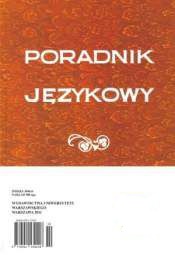PO CO LOGOPEDZIE JĘZYKOZNASTWO, CZYLI JAK DZIECKO UCZY SIĘ FLEKSJI I JAK JĘZYKOZNAWCY MOGA POMÓC W ZROZUMIENIU TEGO PROCESU
WHY THE SPEECH AND LANGUAGE THERAPIST NEEDS LINGUISTICS OR HOW THE CHILD ACQUIRES FLECTION AND HOW LINGUISTICS MAY HELP COMPREHEND THIS PROCESS
Author(s): Marzena StępieńSubject(s): Language and Literature Studies
Published by: Dom Wydawniczy ELIPSA
Keywords: LOGOPEDA; FLEKSJA; JĘZYKOZNASTWO; DZIECKO
Summary/Abstract: The aim of this article is to verify the hypothesis that the sequence and manner of acquiring individual components forming the morphological subsystem of language (flection) by the child is connected with syntagmatic and pragmatic relations which occur between the components of this system. Identifying such correlations is important for determining the so-called development standard with reference to language acquisition. The input material for the analysis is constituted by relevant chapters from the work by M. Smoczyńska (1986) as well as by P. Smoczyński (1955) and M. Zarębina (1965, 1994) devoted to the acquisition of the morphological subsystem by the child. The data obtained from these publications are compared to the information presented in Gramatyka współczesnego języka polskiego. Morfologia (1998). The article presents general conclusions concerned with the flection subsystem. The category of case, in turn, is discussed in more detail. The text is an introduction to the detailed analysis of flection categories presented in the paper titled Zagadki fleksji, czyli jak dziecko opanowuje kategorie werbalne i nominalne [Misteries of flection or how the child acquires verbal and nominal categories], which will be published in issue LXII of „Prace Filologiczne”.
Journal: Poradnik Językowy
- Issue Year: 2011
- Issue No: 09
- Page Range: 5-21
- Page Count: 17
- Language: Polish
- Content File-PDF

